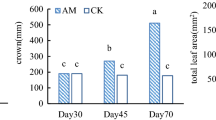Summary
Effectiveness of antitranspirants in reducing transpiration was studied in the laboratory in an attempt to evaluate their potential for conservation and reallocation of soil moisture. Film-forming antitranspirants caused about a 50% reduction of transpiration and photosynthesis in all species. Effectiveness decayed slowly over 10–14 days. Effectiveness of the silicone antitranspirant was very short-lived. Water use efficiency was slightly improved following film-forming antitranspirant treatment of three species. Mixing antitranspirants altered their effects.
Similar content being viewed by others
Literature Cited
Anderson, J. E. and Mc Naughton, S. J., Effects of low soil temperature on transpiration, photosynthesis, leaf relative water content, and growth among elevationally diverse plant populations. Ecology54, 1220–1233 (1973).
Bokhari, U. G. and Singh, J. S., Effects of temperature and clipping on growth, carbohydrate reserves, and root exudation of western wheatgrass in hydroponic culture. Crop Sci.14, 790–794 (1974).
Brooks, K. N. and Thorud, D. B., Antitranspirant effects on the transpiration and physiology of tamarisk. Water Resour. Res.,7, 499–510 (1971).
Cunningham, R. S., Evaluation of transpiration suppressants as an alternative to the eradication of saltcedar thickets. M.S. Thesis, University of Arizona, 56 p. (1972).
Davenport, D. C., Hagan, R. M. and Martin, P. E., Antitranspirants research and its possible application in hydrology. Water Resour. Res.5, 735–743 (1969).
Davenport, D. C., Fisher, M. A. and Hagan, R. M., Retarded stomatal closure by phenylmercuric acetate. Physiol. Plant.24, 330–336 (1971).
Davenport, D. C., Uriu, K. and Hagan, R. M., Effects of film antitranspirants on growth. J. Exp. Bot.25, 410–419 (1974).
Davies, W. J. and Kozlowski, T. T., Short- and long-term effects of antitranspirants on water relations and photosynthesis of woody plants. J. Am. Soc. Hort. Sci.99, 297–304 (1974).
Davies, W. J. and Kozlowski, T. T., Effect of applied abscisic acid and silicone on water relations and photosynthesis of woody plants. Can. J. For. Res.5, 90–96 (1975).
Downes, R. W., Differences in transpiration rates between tropical and temperate grasses under controlled conditions. Planta88, 261–273 (1969).
Fuehring, H. D., Yield of dryland grain sorghum as affected by antitranspirants, nitrogen, and contributing micro-watershed. Agron. J.67, 255–257 (1975).
Gaastra, P., Photosynthesis of crop plants as influenced by light, carbon dioxide, temperature, and stomatal diffusion resistance. Meded. Landbouwhogesch. Wageningen59, 1–68 (1959).
Gale, J. and Hagan, R. M., Plant antitranspirants. Annu. Rev. Plant Physiol.17, 269–282 (1966).
Gale, J. and Poljakoff-Mayber, A., Plastic films on plants as antitranspirants. Science156, 650 (1967).
Hodgkinson, K. C., Influence of partial defoliation on photosynthesis, photorespiration, and transpiration by lucerne leaves of different ages. Aust. J. Plant Physiol.1, 561–578 (1974).
Kreith, F., Taori, A. and Anderson, J. E., Persistence of selected antitranspirants. Water Resour. Res.11, 281–286 (1975).
Koller, D. and Samish, Y., A null-point compensating system for simultaneous and continuous measurement of net photosynthesis and transpiration by controlled gas-stream analysis. Bot. Gaz.125, 81–88 (1964).
Lee, K. J. and Kozlowski, T. T., Effects of silicone antritranspirant on woody plants. Plant and Soil40, 493–510 (1974).
Malcolm, C. V. and Stolzy, L. H., Effect and mode of action of latex and silicone coatings on shoot growth and water use byCitrus. Agron. J.60, 598–602 (1968).
Mishra, D. and Pradhan, G. C., Effect of transpiration-reducing chemicals on growth, flowering, and stomatal opening of tomato plants. Plant Physiol.50, 271–274 (1972).
Mooney, H. A., Dunn, E. L., Harrison, A. T., Morrow, P. A., Bartholomew, B. and Hays, R. L., A mobile laboratory for gas exchange measurements. Photosynthetica5, 128–132 (1971).
Ogunkanmi, A. B., Wellburn, A. R. and Mansfield, T. A., Detection and preliminary identification of endogenous antitranspirants in water-stressedSorghum plants. Planta177, 293–302 (1974).
Parkinson, K. J., The effects of silicone coatings on leaves. J. Exp. Bot.21, 566–579 (1970).
Poljakoff-Mayber, A. and Gale, J., Physiological basis and practical problems of reducing transpiration.In Water Deficits and Plant Growth, Vol III, T. T. Kozlowski, Ed. Academic Press, Inc., New York, p. 277–306 (1972).
Slatyer, R. O. and Bierhuizen, J. F., The influence of several transpiration suppressants on transpiration, photosynthesis and water use efficiency of cotton leaves. Aust. J. Biol. Sci.17, 131–146 (1964).
Stuart, K. L. and Coke, L. B., The effect of vomifoliol on stomatal aperture. Planta122, 307–310 (1975).
Tranquillini, W. and Caldwell, M. M., Integrated calibration of plant gas exchange systems. Ecology53, 974–976 (1972).
Waggoner, P. E., Transpiration of trees and chemicals that close stomata. Proc. Int. Symp. Forest Hydrol., 1965 p. 483 (1966).
Wellburn, A. R., Ogunkanmi, A. B., Fenton, R. and Mansfield, T. A., All-trans-farnesol: a naturally occurring antitranspirant? Planta120, 255–263 (1974).
Zelich, I., Stomatal control. Annu. Rev. Plant Physiol.20, 329–348 (1969).
Zelich, I. and Waggoner, P. E., Effect of chemical control of stomata on transpiration and photosynthesis. Proc. Nat. Acad. Sci.48, 1101–1108 (1962).
Author information
Authors and Affiliations
Additional information
Research supported by the Bureau of Land Management in Cooperation with the Office of Water Research and Technology, United States Department of the Interior (OWRT Grant B-099)
Rights and permissions
About this article
Cite this article
Anderson, J.E., Kreith, F. Effects of film-forming and silicone antitranspirants on four herbaceous plant species. Plant Soil 49, 161–173 (1978). https://doi.org/10.1007/BF02149917
Received:
Issue Date:
DOI: https://doi.org/10.1007/BF02149917




